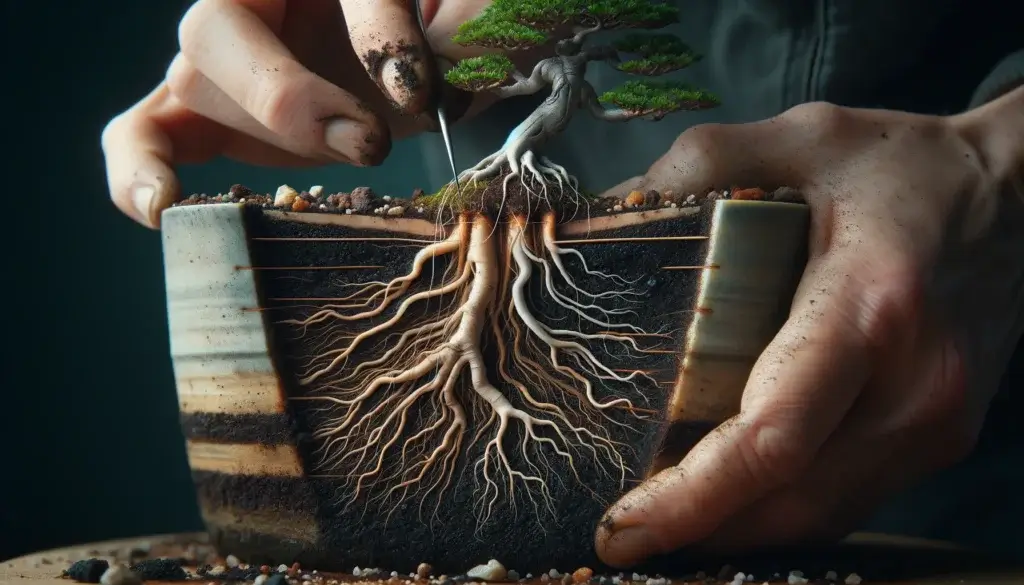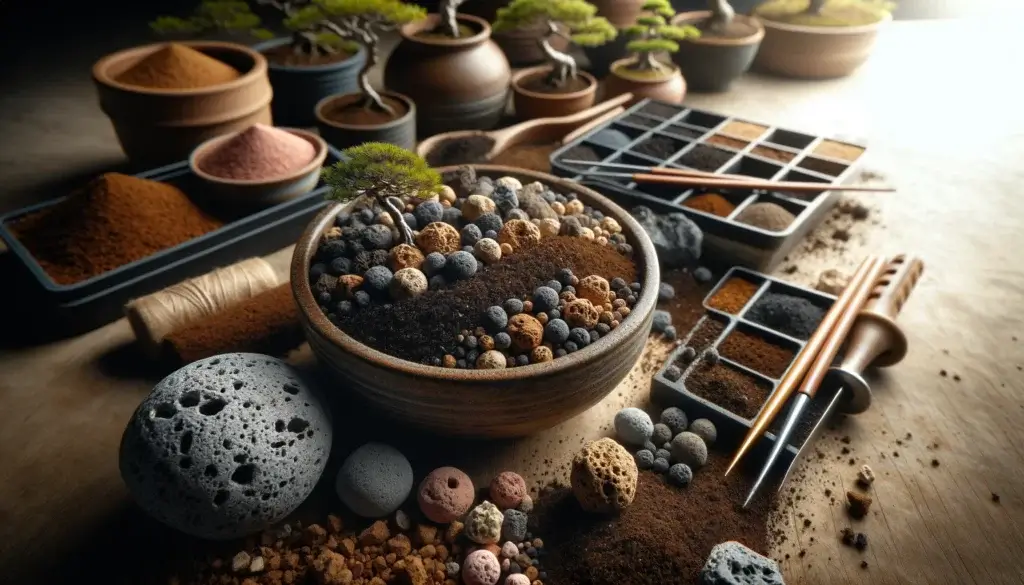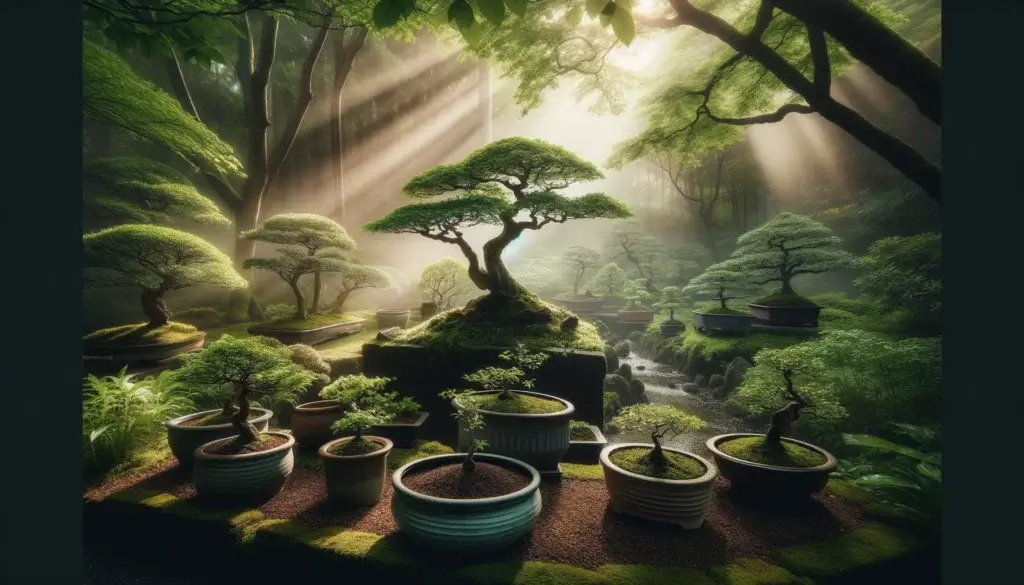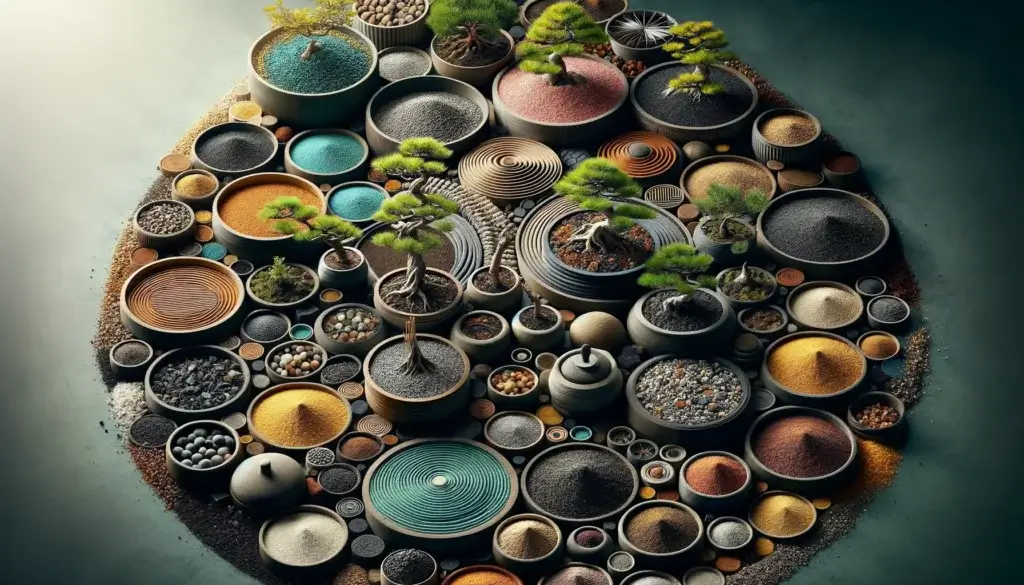
Struggling with your bonsai’s health? The secret may lie beneath its branches in the soil. This article dives into easy-to-follow recipes for creating the perfect bonsai soil mix that promotes robust growth and vitality.
Keep reading to give your miniature trees the foundation they deserve!
Key Takeaways
- Bonsai trees require special soil that drains quickly and prevents root rot, unlike regular garden soil which retains too much water and can compact over time.
- A bonsai soil mix is made of both organic components like peat moss and pine bark for moisture, as well as inorganic materials like perlite and sand to help with drainage and aeration.
- Making your own bonsai soil allows you to tailor the mixture to match the specific needs of your tree species and local climate conditions, whether it’s humid, arid, or temperate.
- Ready-to-use professional all-purpose blends save time but might need slight adjustments based on individual bonsai requirements; premium mixes often contain high-quality ingredients for optimal growth.
- Gritty mixes are particularly good for plants needing excellent drainage such as conifers or those living in dry environments; these prevent root compaction allowing healthy root development.
Understanding Bonsai Soil

Understanding bonsai soil is crucial for the successful growth of your bonsai tree. Unlike garden soil, bonsai soil has specific components and characteristics that are essential for maintaining the health and appearance of your tree.
Proper soil composition ensures adequate drainage, aeration, and nutrient retention to support the unique needs of a bonsai tree.
Differences from garden soil

Bonsai soil has unique qualities that set it apart from typical garden soil. It’s specifically designed to drain water rapidly while still holding onto enough moisture to keep the tree hydrated.
This balance prevents root rot, which bonsais are prone to in denser, wetter soils found in gardens. Regular garden soil also tends to pack tightly over time, limiting air flow and hindering root growth – a problem bonsai mixtures solve with their loose and porous structure.
Your bonsai depends on a tailored mix of ingredients for support and nutrition, unlike garden plants that often thrive in a wide range of soil types. Bonsai soil components allow the roots to breathe and grow without being swamped by excess water or choked by compact earth.
With this understanding, you’re ready to explore what goes into these specialized blends and learn about the importance of proper soil in bonsai growth.
Importance of proper soil in bonsai growth

Proper soil is crucial for bonsai growth as it provides essential nutrients, aeration, and drainage. The right soil mixture supports root development, helping the tree to establish a healthy foundation and absorb vital moisture and nutrients.
Quality bonsai soil promotes healthy growth by ensuring that the roots are not waterlogged or deprived of oxygen, leading to overall plant vitality.
A balanced blend of organic and inorganic components in bonsai soil maintains an optimal environment for the tree’s health. It encourages beneficial microbial activity which aids in decomposition and nutrient availability, while also allowing excess water to drain effectively.
Components of Bonsai Soil
Understanding the components of bonsai soil is crucial for its successful growth. Organic components such as peat moss, pine bark, and compost provide nutrients and retain moisture, while inorganic components like perlite, pumice, and sand improve drainage and aeration.
Mixing these components in the right proportions creates an optimal environment for your bonsai tree to thrive.
Organic components

Organic components play a crucial role in bonsai soil mixtures, providing essential nutrients and fostering microbial activity. Components like compost, peat moss, and pine bark enhance the soil’s ability to retain moisture and promote root development.
They also contribute to overall soil structure, ensuring good aeration and drainage for healthy bonsai growth.
Balancing organic components with inorganic elements is key to creating an optimal bonsai soil mix that supports plant health and vigor. By incorporating organic matter into the substrate, you can recreate natural conditions for your bonsai trees, encouraging strong growth and resilience against diseases and pests.
Inorganic components

After understanding the organic components of bonsai soil, it’s essential to recognize the role and significance of inorganic components. These elements provide stability and aeration to the soil mix.
Inorganic particles such as grit, coarse sand, and small gravel help improve drainage and prevent compaction. Additionally, they contribute to anchoring the roots while allowing for proper airflow within the soil.
Selecting appropriate inorganic components is crucial in ensuring optimal water retention and nutrient distribution for your bonsai trees.
When crafting your own bonsai soil mix or choosing a commercial blend, considering the right balance of inorganic components is vital for promoting healthy root growth and overall plant vitality.
Making Your Own Bonsai Soil Mix

Once you understand the components of bonsai soil, making your own mix is easy. With the right tools and a step-by-step process, you can create a blend that’s perfect for your tree’s specific needs based on its species and climate.
Tools needed

To make your own bonsai soil mix, you will need the following tools:
- Measuring cups and spoons to ensure accurate proportions for the recipe.
- A large mixing container to evenly blend the soil components.
- Sieve or mesh screen to sift out fine particles and debris from the soil mixture.
- Watering can with a fine nozzle for moistening the soil mix during preparation.
- Work gloves to protect your hands when handling soil components.
- Large plastic bags or containers for storing any leftover soil mix.
Step by step process

Once you have all the necessary tools, follow these steps to make your own bonsai soil mix:
- Begin by gathering the organic and inorganic components of your choice.
- Measure out the desired quantities of each component according to your chosen recipe.
- Place the organic and inorganic components into a large container or mixing bowl.
- Thoroughly mix the components together until they are evenly distributed.
- Ensure that the soil mix has achieved a consistent texture throughout.
- Test the moisture level of the soil mix to ensure it is suitable for your bonsai tree’s needs.
- Once satisfied, your homemade bonsai soil mix is ready to be used for potting or repotting your bonsai tree.
Recommended recipes based on tree species and climate

Tailoring your bonsai soil mix to suit specific tree species and varying climates is crucial. It ensures that your bonsai receives the right balance of nutrients, water retention, and drainage. Below you’ll find a table with recommended recipes that cater to different species and climates, taking into account their unique requirements.
| Tree Species | Climate | Soil Mix Recipe |
|---|---|---|
| Conifers (e.g., Pine, Juniper) | Temperate | 1 part Akadama, 1 part Pumice, 1 part Lava Rock |
| Deciduous (e.g., Maple, Elm) | Humid | 2 parts Akadama, 1 part Kanuma, 1 part Bark Fines |
| Tropical (e.g., Ficus, Schefflera) | Warm | 3 parts Akadama, 1 part Pumice, 1 part Organic Compost |
| Desert plants (e.g., Baobab, Jade) | Arid | 1 part Akadama, 2 parts Pumice, 1 part Coarse Sand |
| Flowering (e.g., Azalea, Camellia) | Varies | 2 parts Kanuma, 1 part Peat Moss, 1 part Pumice |
Tailor your mix further based on local weather patterns and indoor versus outdoor settings. Remember, the right soil mix helps your bonsai thrive.
Top-rated Bonsai Soil Mixes

Discover the top-rated bonsai soil mixes that professional growers recommend for healthy and thriving plants. From all-purpose blends to organic and premium mixes, find the perfect soil mix for your bonsai tree based on your specific needs and climate.
Professional all-purpose blends

Professional all-purpose blends provide a balanced mix of organic and inorganic components, catering to the needs of various bonsai species. These blends are carefully formulated to promote healthy growth and root development while ensuring adequate drainage and aeration.
- Balanced Organic-Inorganic Ratio: These mixes typically contain a well-balanced ratio of organic components such as peat moss, pine bark, or coconut coir, combined with inorganic components like perlite, pumice, or coarse sand. This blend provides an optimal environment for root development and nutrient absorption.
- Nutrient-Rich Composition: Professional all-purpose blends often include essential nutrients such as nitrogen, phosphorus, and potassium to support the overall health and vigor of bonsai trees. These nutrients are released gradually over time, providing sustained nourishment for prolonged growth.
- Enhanced Water Retention and Drainage: The combination of organic and inorganic components in these blends allows for improved water retention without compromising drainage. This ensures that the roots receive adequate moisture while preventing waterlogging, which can lead to root rot.
- Versatility for Different Tree Species: These blends are designed to accommodate a wide range of bonsai species, making them suitable for various climates and growing conditions. Whether you have deciduous trees, conifers, or tropical varieties, professional all-purpose blends offer universal support.
- Ready-to-Use Convenience: With pre-mixed proportions of organic and inorganic materials, these blends save time and effort in preparing custom soil mixes. They can be used straight out of the bag or modified slightly based on specific tree requirements.
- Longevity and Stability: Professional all-purpose blends maintain their structure over time, reducing the need for frequent repotting due to soil breakdown or compaction. This stability contributes to a consistent growing environment for your bonsai trees.
Organic blends

To complement professional all-purpose blends, organic blends provide natural and nutrient-rich options for your bonsai. Here are some popular organic blend recipes to consider:
- Pine Bark and Peat Moss Mix: This mix is great for water retention and aeration, providing the right balance for many types of bonsai trees.
- Akadama and Charcoal Blend: Ideal for moisture regulation and root development, this mix promotes healthy growth in a variety of climates.
- Composted Bark, Lava Rock, and Perlite Combination: Offering excellent drainage, aeration, and nutrient retention, this blend is suitable for trees that require different levels of moisture control.
- Kanuma Soil with Coconut Coir: This combination enhances water retention while maintaining airflow around the roots, making it perfect for acid-loving bonsai species.
- Sphagnum Moss with Pumice Mix: With its ability to retain moisture without suffocating the roots, this blend is excellent for maintaining consistent hydration levels in various environmental conditions.
- Turface and Worm Castings Formula: This mix provides balanced aeration, water holding capacity, and essential nutrients crucial for vigorous bonsai growth.
Premium blends

Premium blends of bonsai soil mix are carefully formulated to provide optimal conditions for your trees.
- These blends often contain a balanced mixture of organic and inorganic components to ensure proper aeration and water retention.
- They are designed to promote healthy root development, essential for the overall well – being of your bonsai tree.
- Premium blends commonly incorporate high – quality materials such as akadama, pumice, and lava rock, which effectively support nutrient uptake and root health.
- Some premium blends may also include ingredients like pine bark or coconut coir to enhance moisture retention and promote robust growth.
- When selecting a premium blend, consider the specific needs of your bonsai tree species and the local climate to ensure the best possible results.
All-purpose blends

When creating your own bonsai soil mix, consider using all-purpose blends. These can be versatile and suitable for a wide range of tree species and climates.
- All – purpose blends are typically balanced in organic and inorganic components to provide good drainage and aeration while retaining moisture.
- This type of mix is suitable for beginners as it can cater to the general needs of various bonsai trees without needing specific adjustments.
- It often consists of components like akadama, pumice, and lava rock, providing an optimal balance between water retention and drainage.
- All – purpose blends are beneficial for maintaining healthy root systems by preventing waterlogging or excessive dryness.
- These mixes are convenient for bonsai enthusiasts who have a diverse collection of trees with varying requirements, offering a practical solution for overall plant health.
- They are also ideal for trees that may require repotting at different times throughout the year due to their adaptable nature.
Gritty mixes
Transitioning to “Gritty mixes,” these soil blends are perfect for species that require excellent drainage and aeration.
- Gritty mixes consist of components like coarse sand, small pebbles, and pine bark to ensure good airflow and water circulation within the soil.
- These mixes are suitable for coniferous trees such as junipers, pines, and spruces, as well as other plants that thrive in drier environments.
- The coarse texture of gritty mixes helps prevent compaction, allowing roots to grow freely and promoting overall plant health.
- Gritty mixes are especially ideal for arid climates or if you tend to overwater your bonsai, as they help prevent waterlogging and root rot.
- When creating gritty mixes, it’s crucial to maintain the correct ratio of components to achieve the desired porosity and drainage for your specific tree species.
- By customizing gritty mixes based on your tree’s needs, you can ensure that your bonsai thrives in an optimal growing medium tailored to its requirements.
Conclusion
In conclusion, you have learned about the crucial differences between bonsai soil and garden soil. You now understand the significance of using proper soil for the healthy growth of your bonsai plants.
Crafting your own bonsai soil mix can be a practical and efficient process with the right tools and guidance. By following recommended recipes based on tree species and climate, you can ensure optimal plant nutrition.
Remember to explore top-rated bonsai soil mixes to find one that best suits your needs. Take action today to provide your bonsai with the ideal growing environment they deserve.
FAQs
1. What goes into a Bonsai soil mix recipe?
A Bonsai soil mix recipe usually includes a blend of ingredients like akadama, pumice, lava rock, and organic potting compost that promote healthy plant growth.
2. Why is the right Bonsai soil mixture important for my plant?
The right Bonsai soil mixture ensures proper drainage and air circulation while providing vital nutrients for your bonsai’s health and development.
3. Can I make DIY bonsai soil mix at home?
Absolutely! You can create your own DIY bonsai soil mix by combining specific ingredients in the correct ratios to suit your particular type of bonsai tree.
4. Are there different recipes for various types of bonsais?
Yes, there are various Bonsai soil blend recipes formulated to cater to different kinds of bonsais based on their unique needs for water retention and root growth.
5. How do I know if my homemade bonsai substrate mix is working well?
Your homemade bonsai substrate mix is working well if you see signs of good plant health such as new foliage growth, strong roots when repotting, and no symptoms of over or under-watering.
